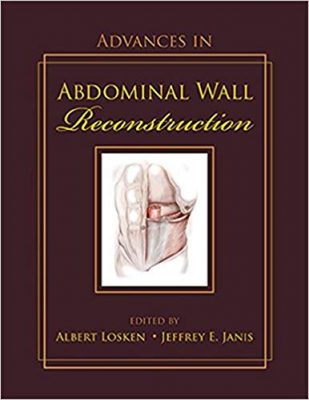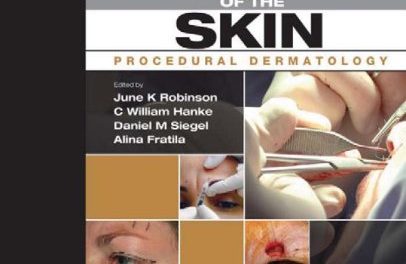 Editors: Albert Losken, MD and Jeffrey E. Janis, MD
Editors: Albert Losken, MD and Jeffrey E. Janis, MD
Publisher: Thieme – 425 pages
Book Review by: Nano Khilnani
“Having seen huge abdominal wall defects without a satisfactory solution (when I trained in general surgery in the 1980s) I began research in the anatomy laboratory,” writes Oscar M. Ramirez, MD, Clinical Assistant Plastic Surgery Professor at Johns Hopkins School of Medicine in his Foreword to this book.
He points out that in the United States, each year about 250,000 patients undergo surgeries to correct abdominal wall defects. The problems are “complex” and the techniques “intricate and demanding.” He adds that “open acute abdominal wall defects have a high mortality rate, and timely or staged reconstruction will save lives.”
Abdominal wall reconstruction is done not just after correcting an abdominal wall defect. Sometimes an exploratory procedure such as a laparotomy is done to determine the extent of a wall defect, disease or abnormal condition such as hernia repair, and after exploration, or surgical treatment.
It is both challenging and rewarding, write the editors Drs. Albert Losken and Jeffrey Janis in their Preface. It is challenging when patients have other unknown comorbidities. It is rewarding when the known condition is treated well surgically, and the patient is able to lead a normal life.
“Individualized, evidence-based treatment plans” should be formulated, Dr. Losken and Janis point out. In addition, they write that these factors listed below are essential in order to achieve optimal success in abdominal wall reconstruction procedures:
- Careful patient selection
- Risk stratification
- Meticulous surgical technique
- Use of appropriate implant materials
There are other sets of considerations, they advise readers, to go through carefully before undertaking abdominal wall surgery:
- Choose the right biologic materials, synthetic meshes, and other items
- Consider and decide upon the diverse locations for mesh placement
- Go through and pick the right method for separating parts and closing fascia
- Think about and pick the best way to prepare the patient for surgery
- Use the best approach to team cooperation for optimal outcome of the procedure
Thirty-two specialists – including the two editors of this book – in several types of surgery including bariatric surgery, general surgery, plastic surgery, reconstructive surgery, wound care and other areas, authored or coauthored the 20 chapters of this book. Of these authors, 29 are from the United States, two from Canada, and one from Brazil. We list the chapter titles below to provide you a broad overview of this book: .
- Fundamentals
- Abdominal Wall Surgery
- Classification and Causes of Abdominal Wall Hernia Defects
- The Treatment of Abdominal Wounds
- Introduction to Abdominal Wound Care
- Synthetic Mesh in Abdominal Wall Reconstruction
- Tissue Biologics in Abdominal Wall Reconstruction
- Hernia Repair
- Controversies in Hernia Repair
- Separation of Anatomic Components Method of Abdominal Wall Reconstruction: Application and Advances in Technique
- The Use of Biologics in Complex Abdominal Wall Reconstruction: Technical Considerations
- Minimally Invasive Ventral Hernia Repair
- Transversus Abdominis Release for Posterior Component
- Outcomes After Abdominal Wall Reconstruction Using Acellular Dermal Matrices: A Critical Review of Existing Literature
- Open Versus Laparoscopic Ventral Hernia Repair
- Complex Hernia Repair
- Coverage Issues in Abdominal Wall Reconstruction
- Parastomal Hernias
- Enterocutaneous Fistulas: Current Concepts in Management
- Management of a Postoperative Abdominal Bulge
- Challenging Abdominal Wall Defects
- Management of the Recurrent Ventral Abdominal Hernia
- Abdominal Wall Transplantation
This is an excellent book on abdominal wall reconstruction, the result of a commendable project by specialists, led by two top experienced surgeons and professors in the field.
The materials in each chapter are well organized with an introductory paragraph, topics and subtopics interspersed with “Key Points”, step-by-step instructions, “Outcomes,” an ample number of full-color photographs, charts and tables that make it easier for you to understand the subject matter. At the end of the chapters, you will find a Conclusion, Clinical Concepts and a list of References for further study. A great book !.
Editors:
Albert Losken, MD, FACS is Hamm Professor and Program Director in the Division of Plastic Surgery at Emory University in Atlanta, Georgia.
Jeffrey E. Janis, MD, FACS is Associate Director and Program Director of the Department of Plastic Surgery at the University of Texas Southwestern Medical Center, and Chief of Plastic Surgery at Parkland Health and Hospital System in Dallas, Texas.






